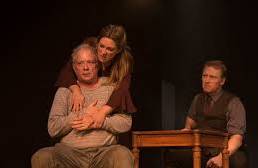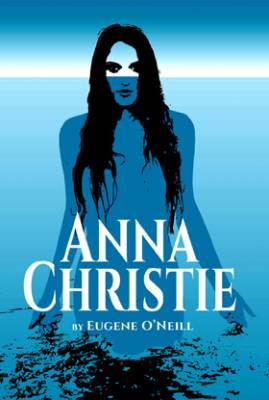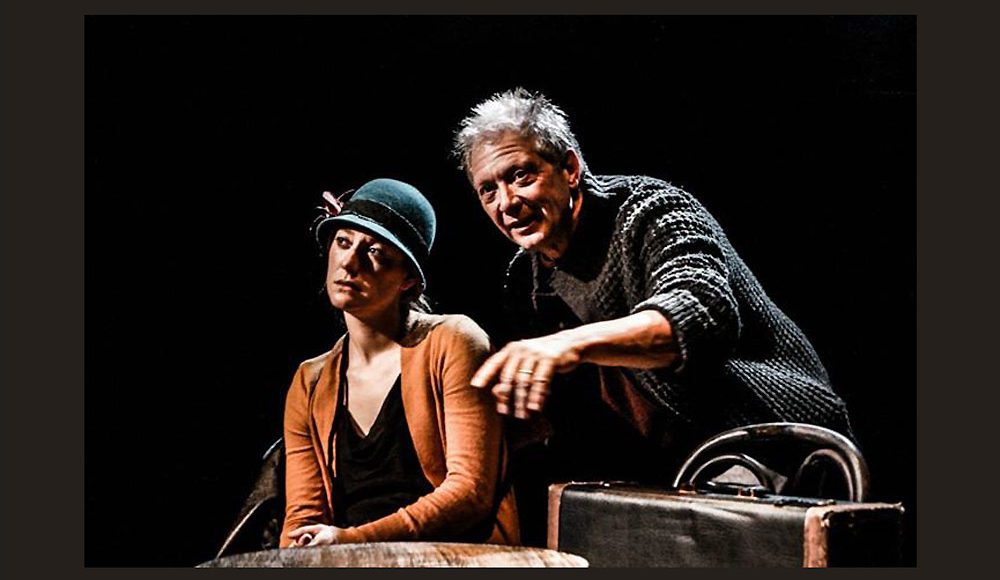In Eugene O’Neill’s Anna Christie the sea defines all things; the characters, their lives, their past, and their destinies.
It is the sea that convinces Chris Christopherson to abandon his young daughter to what he believes will be a better life. For in the sea’s vastness all he finds is the pain of his own insignificance.
Many years later it is the sea where his estranged daughter, Anna, comes seeking her father, and discovers a deliverance from the demons of her own life. For as the sea’s immensity may diminish one’s life in comparison, so too may one’s sins be diminished.
“Here’s to the sea,” proclaims Anna, and if any words spoken in the play are an expression of the author’s sincerest sentiments, these are them. It was as a sailor, on the open ocean, that O’Neill first found the core of his being, and which would one day serve as the wellspring of his creativity.
Beyond the Horizon, The Hairy Ape, Long Days Journey Into Night; there are few of O’Neill’s plays that are far from the sea, and his earliest one acts are commonly called The Sea Plays.
The history of Anna Christie is not without interest.
O’Neill worked long and hard on the play until he deemed it ready for production in 1922. The play was a hit and would win O’Neill the Pulitzer.
Anna Christie was first filmed as a silent film in 1923 with Blanche Sweet in the lead role. But by the late ’20s and well into the early ’30s the film industry in Hollywood was undergoing a grueling period; the conversion of the studios and their players from the era of silent films to “talkies.”
MGM was looking for a vehicle to ensure one of their biggest assets made that transformation successfully: Greta Garbo. Though she would go on to become one of the iconic stars of Hollywood, at the time the likelihood of her making that transition was in serious doubt.
The American movie going audiences reflected the xenophobic, isolationist nation of a whole.
Some of the biggest names of the silent screen had seen their careers shattered all due to the accents they spoke with, and Garbo’s speech was heavily accented.
MGM felt Anna Christie was tailored-made for safeguarding their investment’s entry into sound in that the play’s characters were Swedish as was Garbo herself. MGM was also fortunate in that it was still the pre code period, before Will Hayes with his ironclad morality had been foisted on the industry, and when a tale of a former prostitute who manages to live happily ever after could not have been produced.
The film version was produced and directed by Clarence Brown, but MGM was taking no chances with the filming, and assigned as co-producers both the legendary Irving Thalberg and Paul Bern (most remembered now for his tragic marriage to Jean Harlow).
MGM threw all the studio’s immense clout into marketing the film, and it was their campaign that inserted into the vernacular of American advertising the revered saw of “Garbo Talks!”
With the film’s 1930 premiere MGM’s hopes were met and surpassed. Garbo standing as a star survived the shift into “talkies” and would continue on. The film itself was the highest grossing film of the year and would win both Garbo and Brown Academy Awards.
MGM, reluctant to lose the global market that silent films commanded, in late 1930 filmed a German language version of Anna Christie with Garbo as the only cast member appearing in both. That version had its premiere in Cologne.
It was said Garbo preferred the German version.
Over the years both the film and the play have been regarded as classics.
This has perhaps been one of the reasons the film has never suffered the indignity of a remake with the flavor of the month actress in the lead.
The play itself was subjected to the musical treatment in 1957 by Bob Merrill. It was Merrill’s Broadway debut, before which he was best known for the 1952 novelty song, “How Much is The Doggie in the Window?” The show opened on Broadway as New Girl In Town starring Gwen Verdon and ran for 431 performances. Merrill would go on to do Hello Dollyand Funny Girl.
 The production at the Odyssey, produced by Beth Hogan and directed by Kim Rubinstein has been stripped down to its barest of bones. Gone are the superfluous bar flies. Gone is almost any semblance of a set.
The production at the Odyssey, produced by Beth Hogan and directed by Kim Rubinstein has been stripped down to its barest of bones. Gone are the superfluous bar flies. Gone is almost any semblance of a set.
What remains are the actors on the barest of stages, O’Neill ‘s language and, via Wilson Chin’s wonderfully unsullied set design, the sea.
The results are the purest rendering of O’Neill’s work conceivable.
As always at the Odyssey, the audience is treated to top notch performances.
Zoe Perry excels as Anna, making her redemption both meaningful and dramatically acceptable. Jeff Perry as Chris Christopherson, Anna’s father, manages to convey all the hopes, regrets and pain which O’Neill filled into the character. How much it helped in his performance being the lead’s actual father is a matter of conjecture.
Kevin McKidd, known to fans of the series Rome, fills the role of Mat Burke, and hits the perfect center in portraying the character’s swaggering entry into Anna’s life and the suffering it brings him.
As Marthy Owen the old barfly, Mary Mara gives a strong and solid performance that in lesser hands would be exposed as the exposition device that it is.
All the cast, even Tait Ruppert as the bartender, show the strengths of their talents in their sure and steady handling of O’Neill’s language, the poetic challenge of which is the undoing of many an actor.
But beyond the first rate performances what is present on the Odyssey’s stage first and foremost is the power and the intent of the play.
In Anna Christie the two great currents of O’Neill’s life find union, the sea and Catholicism.
For what is the tale of the play, but the story of Eden’s garden reclaimed.
 Anna returns to her father’s presence after banishing her away from the temptation of the sea. But Anna has found the land held no surety of righteousness. Battered and abused by those who her father entrusted her to she now returns to him, her spirit wounded.
Anna returns to her father’s presence after banishing her away from the temptation of the sea. But Anna has found the land held no surety of righteousness. Battered and abused by those who her father entrusted her to she now returns to him, her spirit wounded.
“I don’t expect him to be different from the rest,” she remarks.
But he is. Whatever his failings as a father, Christopherson loves his daughter.
Ironically, it is in the sea, that her father sought to protect her from, from which Anna finds healing. And it is from the sea that Anna finds the hope of happiness when the sea delivers up to her the half drowned sailor Mat Burke.
Here are our Adam and Eve returned to “earthly paradise.”
It is the relationship that develops between them that finally forces Christopherson to re-examine his life and actions. He rails at Burke and argues with Anna against their involvement. Burke, like Christopherson, is a man of the sea and, while he may not see it, Burke is a man created in Christopherson’s own image.
Both Burke and Christopherson see the sea as an adversary. It is Anna who embraces the sea, and in that acceptance it is Anna who is first healed and then empowered by it.
O’Neill hints at the works biblical source, in that playful way all dramatists employ when tipping their hand to an audience. In the scene where Anna finally confronts her father, telling him the truth of that “farm” he sent her to, she tells him the cause of her downfall, that it was the family’s youngest son, “Paul – that started me wrong.” And as if to underline his indictment of the main author of the Gospel and Christianity’s great salesman, Anna flees the “farm” for the city of St. Paul.
Rubinstein seems to have picked up on the religious undercurrents of the piece. In the scene where Christopherson acknowledges his own guilt in Anna’s downfall, Jeff Perry delivers his dialogue from behind a bare light blub; a poor, perhaps, but nevertheless readable, substitute for a burning bush.
When all is said and done, it is the mark of any great play that its meaning can be sought on a wide assortment of levels. And it is the superior production that allows its audience the opportunity of exploring those levels.
Now it is fitting perhaps to give the closing words to the playwright himself.
“Man is broken,” O’Neill recognized. “He lives by mending. The Grace of God is glue.”
***
Anna Christie is at the Odyssey through March 22 – from. Saturdays 2pm & 8pm – Sundays 2pm. Click HERE for complete information or phone the Box Office for tickets.
Box Office (Photos by Anna McMillan)
310-477-2055 EXT. 2
Box Office Hours
Wednesday – Sunday: 1pm – curtain





